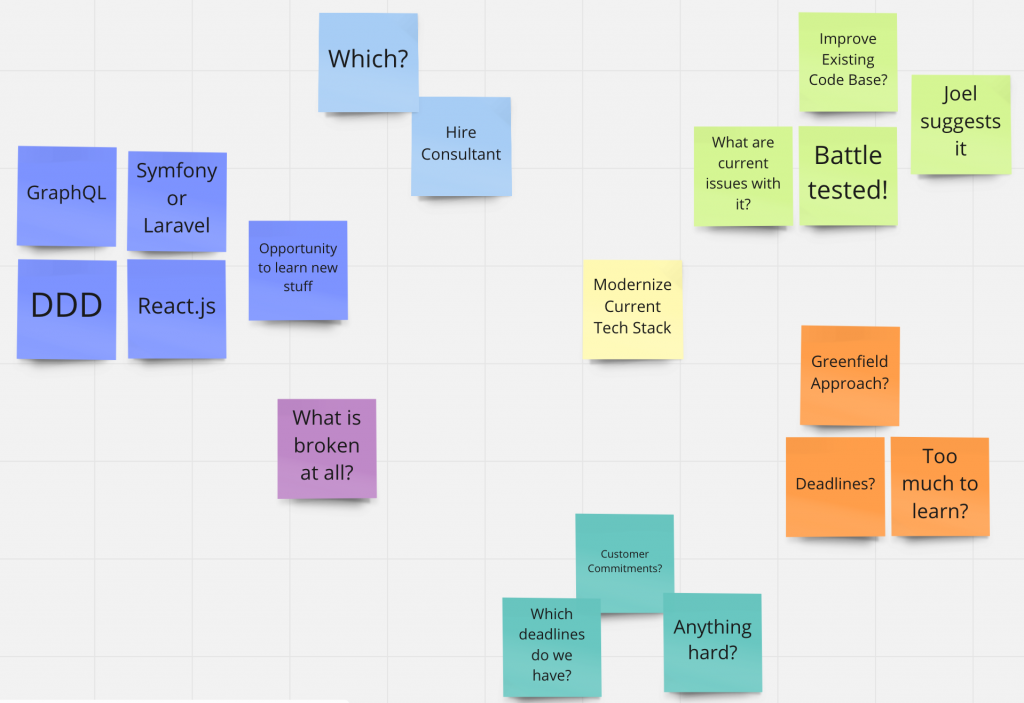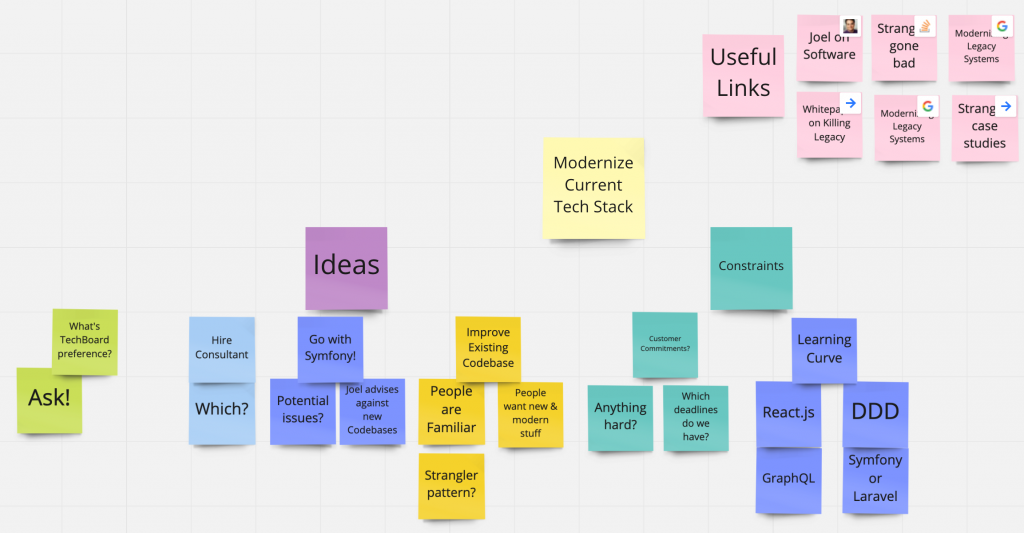
Background
I’m the most chaotic and unorganized person ever. Seriously.
Give me an unknown task and, deep down, I go full blown hazard.
Favorite example is my manager making a request to provide a timeline and plan to do X, where X is usually something that I have no faintest idea about. Gotta admit that he seems to love those!
On the outside, I’d be super-chilled, like – no problem. I’ll do it. But on the inside, it’s like all alarms going off. All my anxieties and insecurities joining together into a beautiful symphony. The YOU WILL FAIL symphony.
- “You don’t know how to do this!”
- “You will suck!”
- “You don’t even know where to start, let alone how to plan it months ahead!”
- “Just admit you are clueless!”
I wrote extensively about this constant fight with my inner voice. You’d think by know I found a way to shut it up, right? Sorry to disappoint you!
Chaos is the perfect metaphor for how I feel when approaching anything new. Anything out of my knowledge and comfort zone is perceived as “dangerous” and hence – made chaotic.
What I learned, and what I’m actually happy about is that I’m not alone. Not even remotely close. No.
The only way to isolate yourself from chaos is to stick to what is familiar and never explore the outsides of it.
And if that’s your game, good for you. But it’s stupid!
It’s stupid because you are avoiding the chaos because you are scared of it. And you are scared because you most likely don’t have tools to deal with it.
I’m also afraid of it. And I hate it. I hate the chaos that an unknown request creates. And yet, I choose to do it.
I’ve dropped quite some sweat trying to develop a framework for battling the chaos and fear that it induces. And that’s exactly what this article is all about – sharing my toolbox for turning chaos into a straight and organized line. Or, shall I say – a timeline.
Understanding Chaos
You might be surprised to learn that chaos is actually the natural state of things. Yep.
Here’s a thought experiment. Think what would happen to your apartment if you left it unmaintained for an extended period of time. Say, a month or a year. Or maybe a decade?
You could vacuum and polish to perfection, but then just leave it as is. Leave it empty and do absolutely freakin’ nothing.
You know what’d happen? In the best short-term case scenario, some dust would accumulate. But given long enough time, think – years, it would eventually start falling apart. Walls would peel off, water would find its way in, eventually destroying everything. And you know, given extra long time, think decades – the nature itself would destroy your precious little home.
Chaos is a natural state of things, whereas the structure is an aim. A battle. An achievable and yet temporary state. Never to be permanent.
As scary as it sounds, it should provide some comfort. And the comfort should be the fact that you get chaos out of the box. So it’s not you that’s chaotic and all others are super-organized and high-achieving. No. Everybody’s chaotic. Everybody’s thoughts are chaotic. It’s just the way the nature works.
What’s different between you and those who are organized is that they have a system. They have a system on how they transform chaos into something meaningful and understandable. Something digestible.
Trust me, even if you THINK you are naturally calm and non-chaotic, it’s more likely that you just came out of the box with a chaos-resolving mechanisms. Someone or something taught you the chaos-converting techniques early on and you perfected them so much that you forget that they are even there. And that’s awesome! But that doesn’t mean that the chaos is not there. It just means you learned and perfected your art early on!
I guess I’m lucky enough to be in the never-learned-how-to-handle-chaos team, and as a diligent student and practitioner of the art, I appreciate the opportunity of documenting my learning process.
Let’s start from the bottom-up.
Step 0 – Acknowledge the Chaos
Let me be clear. The moment you face or hear or are requested to do something that you didn’t repeat gazillion times in the past, you will likely experience the chaos. The paralysis. What the hell do I do? How do I do it? Where to even start? It’s all complex and fuzzy.
At this point, I want you to acknowledge that this is EXACTLY the way it should be. It’s okay. It’s not you but it’s just the way it is. For everyone. And yes, I mean everyone.
Well, I take that back. Gotta digress a bit here. Look, chaos is ever-present, it’s a fact. But it’s our own emotions that make it more complicated than it should be. Our fears, anxieties, insecurities, … you name it and it’s playing against you. And it makes sense really because if there was no fear of starving to death, there would be no action to actually go and get some food. Emotions are right there to push you to survive; and reproduce. But truthfully, they do make things more complex than they should be.
The reason I digressed from the “it’s the same for everyone” is because there are people who can’t experience emotions. Or at least not fully. They feel no fear nor anxiety and are not afraid of the chaos. They are called psychopaths. Really. Look it up. And before you start regretting the fact that you are not one of them, let me tell you – it’s a shitty life. And a boring one too. And yes, I know that because I really invested quite some time learning about them, because I believed that I’m the one at loss for having the opportunity to experience the full spectrum of emotions.
So yeah, there is a minority of people who truly don’t get anxious about a chaos. But it’s a handful!
I digress now.
As I said, when faced or asked to deal with something unknown, first step is to acknowledge that it’s OKAY. It’s okay to feel chaotic and nervous and scared. It’s okay and you’re not alone. We’re all in the same sauce.
Here’s the most recent mega-chaotic example that I’ve experienced. We’ve been working on an attempt to modernize our existing core system and this effort that was initially estimated to last around couple of months, has been full-blown taking years now. As a lead of the initiative, I was engrossed in it from the very beginning. Suffice to say I was taking everything about it more than personal. It was (and is) my child!
“Man”, my manager muttered, “we need to figure out what to do with this initiative”.
“Fuck. He’s right. This thing wasn’t bringing the value that it promised to. But what else would we do? What? Rethink everything now? Redo all? Kill it all with fire? Urgh!”. This simple question created an utter chaos in my head.
And yet, I’ve recognized the pattern. I recognized the poison created by mixing emotions with a fear of an unknown. The chaos.
I’ve acknowledged it.
Step 1 – Map it out
Wikipedia defines the chaos theory as follows:
Chaos theory states that within the apparent randomness of chaotic complex systems, there are underlying patterns, interconnectedness, constant feedback loops, repetition, self-similarity, fractals, and self-organization.
Source: Wikipedia
Your thoughts might seem to be chaotic and unorganized, and that’s fine. But, your job is to go through them with a fine-tooth comb and figure out the patterns and connections.
This is where mind-maps come into play. Mind-mapping is a technique of mapping out your thoughts as they appear. Literally putting them on paper if you will.
Very nice thing about it is that if anybody tells you that there is a specific way of doing it, they are either lying, are unexperienced or are trying to sell you something (e.g. a mind-mapping tool). There is no PROPER way to mind-map your thoughts!
The only proper thing about it is the IDEA.
The idea is that you write out EVERYTHING that comes to your mind as a result of thinking of the chaotic thing.
Here’s a (modified) example of how I started brainstorming the idea of how to modernize our platform architecture:

What you are looking at is Miro board. Miro is a tool best-described as an online (white)board allowing you to do pretty much anything. What I love about it is flexibility. Flexibility in that you can use it in any way you find suitable.
NOTE: I’m in no way related to Miro board! I’m just using a free version of it that allows me to create up to three boards for free.
My way is rather simple. I’d start by placing a huge sticky note outlining WHAT is it that I’m trying to solve.
Next step is to write down everything that is floating around your head. Every thought. Every concern. Every idea. Every “fuuuuck”. Everything.

Again, there’s no proper way to do it. The whole idea is to simply move everything from your head to the board.
I’m pretty sure you’ve seen at least one detective show where they map out the clues, ideas, etc. on sticky notes, right?

That’s exactly what you want to do. Be chaotic as much as possible but GET. IT. OUT.
Before proceeding to next step, here is one important thing to keep in mind – this is not a ONE-TIME and RIGHT NOW process. No. You need to think of it as a BEGINNING of a long-term process.
Start now, then leave it as is and let your subconscious do the work for you. Once you make some mental space, you will start getting new ideas and questions, and as you do, you will want to write them down as well. Rinse & repeat!
Step 2 – Organize It
Look, assuming that you did the Step #1 and mapped out everything, you’re actually more than half-way there. You’ve transformed your UNKNOWN CHAOS into a KNOWN one and that’s a huge step. Congrats!
Depending on the nature of the problem, you might be seeing the solution already. If that’s the case – awesome! Go for it! Or better yet – make a NEW sticky note with solution and see if anything better comes up.
Now, if there’s no solution on horizon yet – kein problem. It’s expected and how it should be.
Your next task is to take those sticky notes and organize them into meaningful units.

Again, there’s no right or wrong here. The point is to group the similar stickies and merge them into something more clear. The GOAL and outcome here is to have a better understanding of the problem and a good overview of problem-solution clusters.
Finally, what’s really important is to let it all sink. Don’t try jumping from Step 1 to Step 2 to Step 3. You want to let the time and your subconcious do the heavy lifting here. So, organize the stuff and LEAVE IT.
Step 3 – Make a Plan
Assuming that you’ve identified the unknowns, wrote them down and clustered them into meaningful groups, you are likely to already have an idea on how to attack the problem. If so – good!
If not, no problem! It’s highly likely that you haven’t explored all issues yet, so feel free to repeat Steps #2 and #3 until you have a better understanding of what you are trying to solve.
Next step is to make a battle plan. WHAT is it that you want to do, HOW are you going to do it and WHICH steps are you going to take. Again, no specific structure and do whatever you feel comfortable with! But your aim is to create a plan. A Timeline, if you will!
Don’t be afraid of using Excel as a support. I usually use combo of mind-mapping and excel, and it never failed me. Simply map out weeks, months or whatever you find comfortable and start filling them up.

One thing I’ve learned is:
At the end of the day, it’s not about having a super-accurate plan, but more about having a plan at all. Bad plan is better than no plan!
So, start by making a rough but shitty plan. Then appreciate what you did and rework it couple of times. Few iterations in, and I guarantee you – you will have more than a solid one!
Another thing worth mentioning is what actually happened here. If you observe carefully – we started with a complete chaos in Step 0, and ended up with a (time)line 🙂
It never ceases to amaze me how incredible it is. Going from the place of “I will never be able to do this” to “Ok, I think this could work out if we did X, Y and Z, …”. It’s simple and yet powerful. And it works!
Step 4 – Rinse & repeat
Suffice to say, you can repeat the above process for as long as you want.
BUT! And here’s a BUT – try not to overcomplicate.
I myself have been a victim of literally iterating over and over and over, because each time you refine it, you see a bit better and more efficient way to do it. Don’t do that to yourself. Just … don’t.
My advice:
Set a deadline and once you reach it, whatever you have at the time should become your final plan.
Can you do it faster?
Look, I have to warn you upfront that my girlfriend calls me “hubbie the snail”. I admit, it sounds funnier in Serbian (“muž puž”), but the fact remains – I seem be a bit on the “slower” side when it comes to … doing stuff. Frankly, if you ask me, I’d say that i’m doing it the PROPER way, while everybody else is going the sloppy route, but I digress.
So, can you do it faster instead of spending days between steps? I’m sure you can. To be honest, most of the time I’d solve the stuff within a day or two. Sometimes on the same day.
The complexity of the problem and the amount of chaos it creates in you is the determining factor here. If it’s something you’re completely unfamiliar with, you’ll simply need time to map out WHAT you don’t understand, then go and learn that, which arms you with more knowledge, potentially opening new areas to explore.
My opinion and experience is that, at the end of the day, you always solve it in just the perfect timing. And if not, well, deadlines have the power of making you do so!
Useful resources
Here’s a list of some resources that you might find useful:
- Draw.io — just overall amazing free tool for drawing diagrams. I use it on daily basis for architecting out problems, collaborating with people or just trying to get to deeper root of the problem.
- Miro.com — online board that I rely on. They seem to come with tons of templates, features and video lessons. I haven’t checked ANY of those, but it seems promising for anyone interested.
- Mindmeister.com — I used to use them before I came around Miro. It’s a really cool mind-mapping tool but it was on a bit more expensive side (around $36 for 6 months).
- Event Storming — I don’t have experience with it, but from what I’ve heard, event storming seems to be a fast & efficient method for mapping and resolving stuff. It very well could be a way more structured approach to what I’m playing with, so it’s most certainly worth checking out (just go and google for it).
Summary
- Facing an unknown task is scary and, unless you have your technique worked out, it will create a chaos in your head.
- Nothing to be scared of – chaos is a natural state of things! Everyone is chaotic by default.
- What you need to work on is mastering the technique of turning Chaos into a Line.
- There’s no silver bullet here. What I can offer you is my approach to resolving chaos.
- Step 0 – be OK with the fact that chaos is present; it was, is and will always be there. It’s fine.
- Step 1 – map it out. Be it a mind map or sticky notes, everything has to go out from your head in to the paper (or board).
- Step 2 – organize your chaotic thoughts by creating clusters of related stuff.
- Step 3 – make a plan; even a shitty one works. Excel is a good choice here.
- Step 4 – rinse & repeat until solved.
- Good luck!
You might also like:
- I’m as anxious as you are; I just choose to do it
- How long is your NEVER?
- Art of Starting Things (or How to Start Doing Things That You’ve Been Delaying Forever)
- Do something that you suck at
If you want to stay up to date about what’s happening on this blog, you may befriend me on LinkedIn, follow my posts on Instagram and Twitter, or subscribe to RSS feed.
You may also subscribe to my mailing list:

Absolutely love this post!
Thank you!!! 🙂